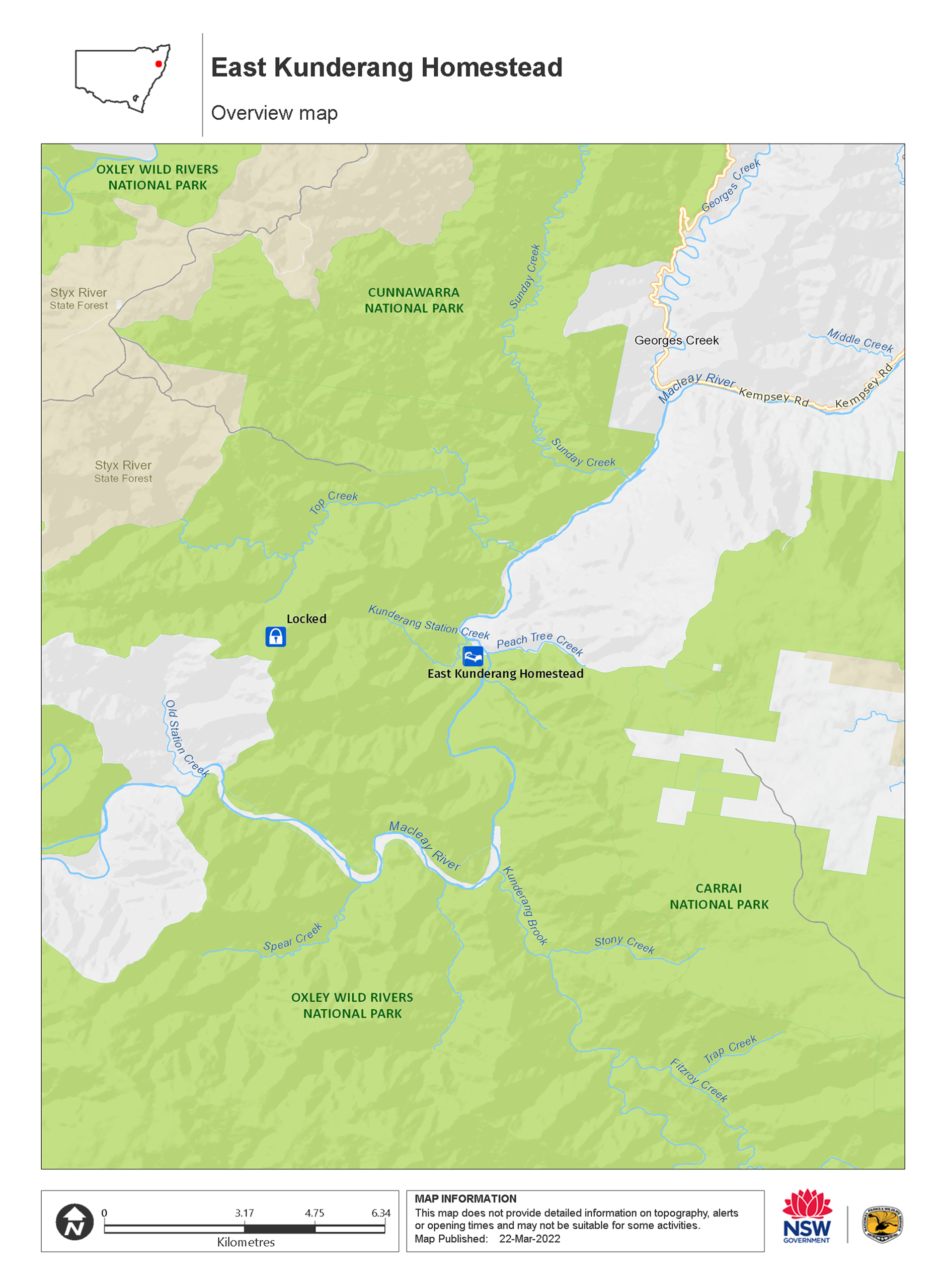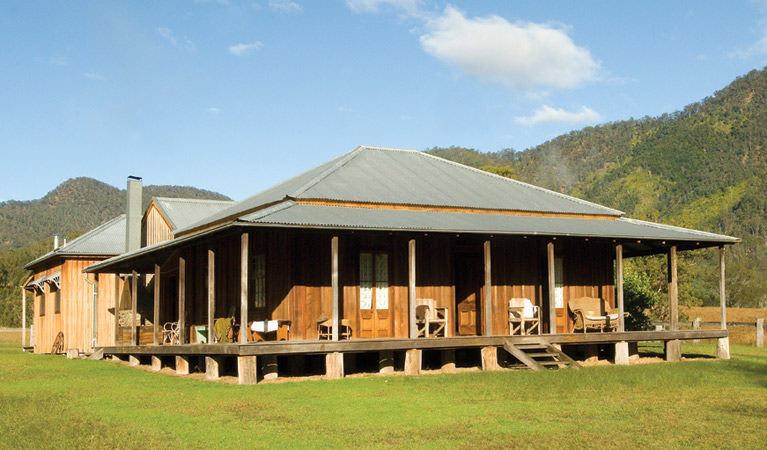East Kunderang Homestead
Oxley Wild Rivers National Park
Overview
East Kunderang Homestead offers beautifully restored heritage accommodation for up to 14 people.
| Accommodation type | Homestead |
|---|---|
| Where | 1539 East Kunderang Road, Jeogla, NSW, 2350 - in Oxley Wild Rivers National Park |
| Bedrooms | 5 |
| Maximum guests | 14 |
| Facilities | Picnic tables, barbecue facilities, public phone, showers, toilets, balcony, kitchen, plates and cutlery, pots and pans, rubbish bin |
| What to bring | Bed sheets, pillows, pillow cases, blankets, towels |
| Please note |
|
East Kunderang Homestead is a historic cedar slab homestead, built in the 1890s, set spectacularly among the mountains and valleys of Oxley Wild Rivers National Park.
Once part of an extensive grazing property, its existence tells a fascinating story of European occupation of the north coast and pioneer life on an isolated pastoral station. It's also an important part of the Aboriginal history of the area.
The historic homestead has been carefully restored to provide comfortable heritage accommodation for up to 14 people. There are five bedrooms, a lounge and dining room, a modern kitchen and two bathrooms, so there is plenty of room for a family or group of friends.
There are also lots of activities to keep you occupied, including swimming and paddling or a spot of fishing in the nearby river, as well as easy walking tracks and opportunities for birdwatching.
The homestead’s wide verandah is the perfect place for relaxing in the afternoon sun, enjoying the view and splendid isolation of the property.
Map

Map legend

Local alerts
For the latest updates on fires, closures and other alerts in this area, see https://www.nationalparks.nsw.gov.au/camping-and-accommodation/accommodation/east-kunderang-homestead/local-alerts
Bookings
- National Parks Contact Centre
- 7am to 7pm daily
- 1300 072 757 (13000 PARKS) for the cost of a local call within Australia excluding mobiles
- parks.info@environment.nsw.gov.au
Operated by
- Armidale office
- Monday to Friday, 8.30am to 5pm.
- 02 6738 9100
- npws.nea@environment.nsw.gov.au
- 145 Miller Street, Armidale NSW 2350
Park info
- in Oxley Wild Rivers National Park in the North Coast and Country NSW regions
Oxley Wild Rivers National Park is always open but may have to close at times due to poor weather or fire danger.
-
There are 3 areas in Oxley Wild Rivers National Park where you'll need day use vehicle permits: Halls Peak campground and picnic area, Riverside campground and picnic area, and Youdales Hut campground and picnic area. Day use vehicle permits can be bought online or by calling the National Parks Contact Centre on 1300 072 757. If camping, permit fees are included in the campground fee.
Contact us for permits.
Visitor info
All the practical information you need to know about East Kunderang Homestead.
Maps and downloads
Learn more
East Kunderang Homestead is in Oxley Wild Rivers National Park. Here are just some of the reasons why this park is special:
A national first

John Oxley was the first European to visit the New England region, passing through the area that is now Oxley Wild Rivers National Park in September 1818. Following Oxley, cedar-getters penetrated the remote and inaccessible gorges followed by pioneer cattle grazers who braved the remote wilderness for a hundred years. Between 1893 and 1894 the first commercial hydro-electric scheme was constructed to power the town and gold mines of nearby Hillgrove. Today you can visit the remains of this historical site when you take a walk along the Threlfall Historic walk.
- Threlfall walking track Threlfall walking track in Oxley Wild Rivers National Park takes in the spectacular Gara Gorge wilderness area, with scenic views and a chance to see the historic hydro-electric scheme.
Abundant wildlife

The varied plant communities of Oxley Wild Rivers National Park provide a home for over 350 animal species, including the largest confirmed population of brush-tailed rock wallabies. Even though there are roughly 10,000 of this endangered species in the park, you'll have to keep your eyes open to catch a glimpse of their bushy tail. The park also boasts over 173 bird species, including the majestic wedge-tailed eagle, peregrine falcon, square-tailed kite and sea eagle.
- Dangars Falls walking track Dangars Falls walking track is a great introduction to the waterfalls, rivers and gorges of Oxley Wild Rivers National Park, near Armidale. A short and easy stroll, it delivers you right into the heart of this vast World Heritage Area.
- The Green Gully Track Experienced bushwalkers will enjoy rising to the challenges offered by The Green Gully Track in Oxley Wild Rivers National Park, near Walcha. Bookings are necessary to secure your experience on this 65km hike over 4 days through declared wilderness areas and dramatic gorges.
- Threlfall walking track Threlfall walking track in Oxley Wild Rivers National Park takes in the spectacular Gara Gorge wilderness area, with scenic views and a chance to see the historic hydro-electric scheme.
Ancient lands

Oxley Wild Rivers National Park is part of the Gondwana Rainforests of Australia World Heritage Area. The park contains some of the best examples of dry rainforest communities in Australia. When you are out exploring the wet and dry eucalypt forests, grassy woodlands and heathlands of the park, look for native olives, lacebarks, shiny-leaved and giant stinging trees, shatterwoods, scentless rosewoods and red kamalas.
Jaw-dropping scenery

With dramatic ridges and gorges, towering rock outcrops and beautiful rivers and waterfalls, there is something new around every corner and you'll be constantly amazed by the views. The sight of a majestic wedge-tailed eagle soaring high above the gorges looking for food is a truly spectacular sight to behold. Don't forget your camera, give yourself plenty of time and keep your eyes open.
- Budds Mare lookout Enjoy a picnic lunch at Budds Mare lookout surrounded by World Heritage listed rainforest and looking out to spectacular views across the Apsley River.
- Dangars Falls walking track Dangars Falls walking track is a great introduction to the waterfalls, rivers and gorges of Oxley Wild Rivers National Park, near Armidale. A short and easy stroll, it delivers you right into the heart of this vast World Heritage Area.
- The Green Gully Track Experienced bushwalkers will enjoy rising to the challenges offered by The Green Gully Track in Oxley Wild Rivers National Park, near Walcha. Bookings are necessary to secure your experience on this 65km hike over 4 days through declared wilderness areas and dramatic gorges.
- Tia Falls walk Tia Falls walk in Oxley Wild Rivers National Park is great for children. A short, easy walk, it offers spectacular views of Tia Falls and Gorge.
Plants and animals protected in this park
Animals
-

Swamp wallaby (Wallabia bicolor)
The swamp wallaby, also known as the black wallaby or black pademelon, lives in the dense understorey of rainforests, woodlands and dry sclerophyll forest along eastern Australia. This unique Australian macropod has a dark black-grey coat with a distinctive light-coloured cheek stripe.
-

Eastern water dragon (Intellagama lesueurii lesueurii)
The eastern water dragon is a subaquatic lizard found in healthy waterways along eastern NSW, from Nowra to halfway up the Cape York Pensinsula. It’s believed to be one of the oldest of Australian reptiles, remaining virtually unchanged for over 20 million years.
-

Southern boobook (Ninox novaeseelandiae)
The southern boobook, also known as the mopoke, is the smallest and most common native owl in Australia. With a musical 'boo-book' call that echoes through forests and woodlands, the southern boobook is a great one to look out for while bird watching.
-

Tawny frogmouth (Podargus strigoides)
Found throughout Australia, the tawny frogmouth is often mistaken for an owl due to its wide, powerful beak, large head and nocturnal hunting habits. The ‘oom oom oom’ call of this native bird can be heard echoing throughout a range of habitats including heath, woodlands and urban areas.
-

Peron's tree frog (Litoria peroni)
Peron’s tree frog is found right across NSW. These tree-climbing and ground-dwelling Australian animals can quickly change colour, ranging from pale green-grey by day, to a reddish brown with emerald green flecks at night. The male frog has a drill-like call, which has been described as a 'maniacal cackle’.
-

Spotted-tailed quoll (Dasyurus maculatus)
The spotted-tailed quoll is the largest remaining carnivorous marsupial on the Australian mainland. It’s protected as a vulnerable species in NSW.

